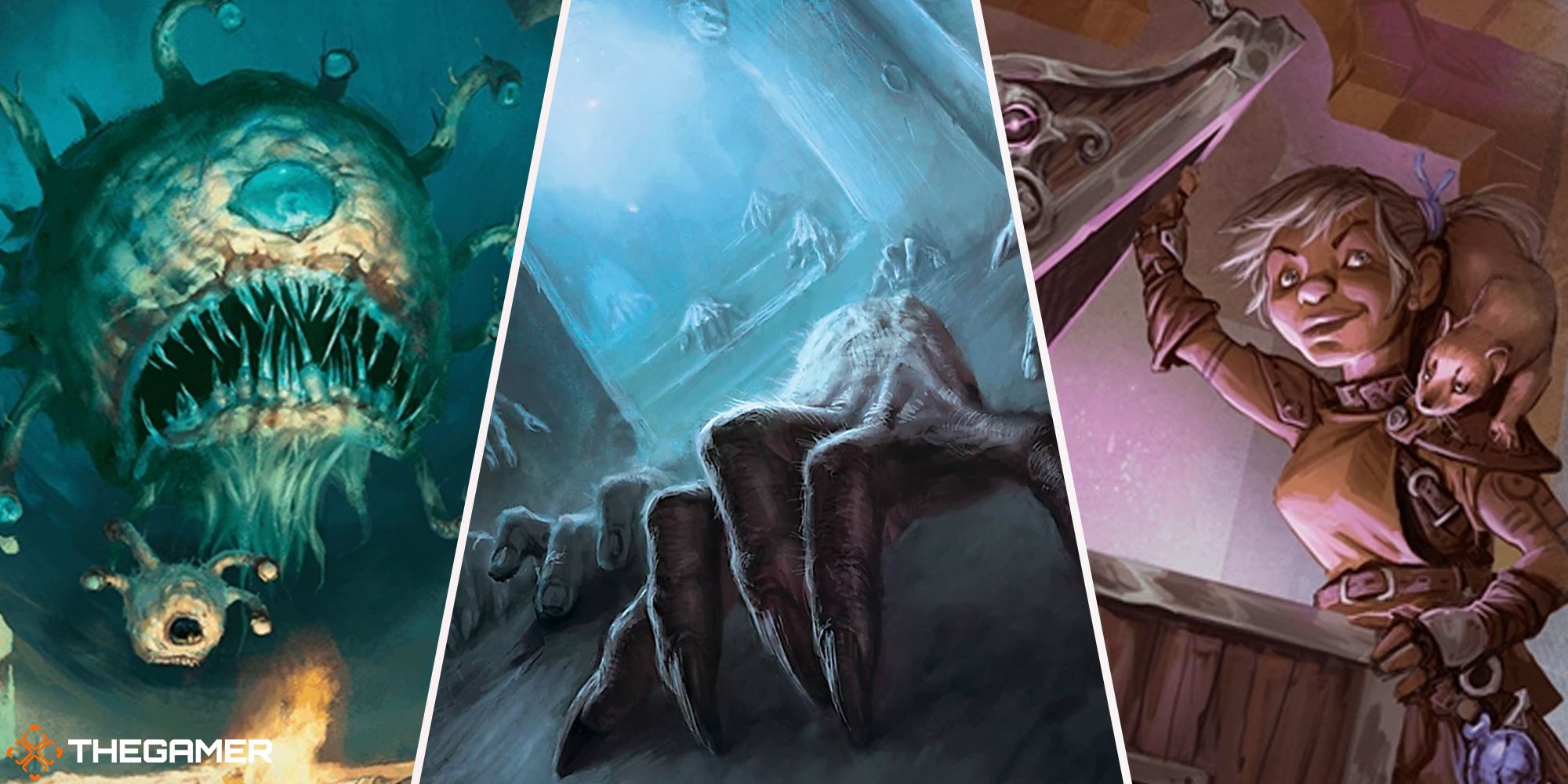
In Dungeons & Dragons, familiars are spirits in the service of a given character, most often taking the form of an animal or another small creature. Familiars are most often in the service of spellcasters; namely Wizards, Druids, and Warlocks of the Pact of the Chain, though characters of any class can hypothetically gain a familiar through the Magic Initiate Feat.
RelatedDungeons & Dragons: Most Physically Strong Monsters
These monsters take toughness to a whole new level.
Posts 3While most familiars are unable to use the attack action, they take their own turns in combat and are able to take actions to interact with objects and notably help your allies. As familiars assume a variety of forms, each with their own stats and abilities, they vary in quality through their flexibility and potential uses. So today, let's examine the most useful types of familiars players can summon in Dungeons & Dragons.
Updated on March 23, 2025, by Alfredo Robelo: The familiars available in Dungeons & Dragons have been updated greatly in both the 2024 Player's Handbook and the 2025 Monster Manual. We've updated this article to include the most recent and varied options, particularly when it comes to Pact of the Chain warlocks.
26 Skeleton
Art by Andrey Kuzinskiy- Perfect soldiers and helpers.
One of the most unexpected familiar options introduced in the 2024 Player's Handbook is the skeleton, a creature often used for players to fight against, not beside. Exclusive to warlocks, this familiar excels at melee and long-range combat, as well as having a respectable AC of 14.
However, one of the best uses a player will have for this familiar is its medium size. This makes the skeleton capable of performing the most basic tasks a player can; including carrying equipment, moving objects around during a puzzle, and dragging unconscious characters out of harm's way.
25 Slaad Tadpole
Art by David Astruga- Burrow speed.
- Great storytelling potential.
Being able to summon a slaad tadpole (or any kind of tadpole for that matter) as a familiar is incredibly odd, which makes it already one of the most unique familiar options out there. When it comes to combat, it isn't anything special, but it can resist all kinds of damage and even magical effects.
A slaad tadpole found in the wild will often mature in less than 24 hours from hatching, which you can use as a Dungeon Master for all kinds of storytelling purposes. This unassuming familiar could end up transforming into a full-grown blue slaad after a long rest, either antagonizing the party or enticing them with a dangerous quest in Limbo.
24 Sphinx Of Wonder
Art by Hazem Ameen- Flies and aids on D20 tests.
The sphinx of wonder is another familiar exclusive to warlocks, with the ones with a celestial patron getting the most flavor out of it. This creature can fly, help in combat with radiant damage, and it's able to resist magical effects cast on it by having advantage on saving throws for them.
The main special ability it has is a reaction, known as Burst of Ingenuity. It can only use it twice per day, but it allows the sphinx of wonder to add a plus two to any ability checks or saving throws happening around it, being a great defensive help not only to its master, but for the entire party.
23 Quipper
Art via Wizards of the Coast.- Perfect for underwater adventures.
Quippers are a very interesting familiar choice, as they only function within the water. Outside of it they are easily the most useless familiar option available, since they will quickly suffocate. However, if a campaign or adventure has led itself underwater, they can offer incredible value.
WIth 60 feet of darkvision and a 40-foot swimming speed, Quippers can easily maneuver around a battlefield. They are able to move up to 80 feet in a single turn with the dash action. This makes them one of the most ideal familiar options when traveling underwater.
22 Spider
Art via Wizards of the Coast- Darkvision and a bonus to stealth makes it a great scout.
- Casting the Web spell lets the spider guard for intruders.
Spiders are a niche familiar choice that can be surprisingly effective. With a tiny size and a +4 bonus to stealth checks, Spiders can make for solid scouts, making use of a 30-foot darkvision range.
RelatedDungeons & Dragons: What Is An Arch-Hag?
Introduced in the 2025 Monster Manual, arch-hags are powerful magic beings that can either help or curse your party in D&D.
PostsWhile Spiders’ ability to ignore the movement restrictions of webs and their ability to automatically detect creatures in webs its touching may seem very niche, Wizards have access to the web spell. This means that the use of the web spell and a Spider familiar can allow a player to quickly find invisible or hiding creatures, a powerful tool to have.
21 Weasel
Halfling Warlock from Mordenkaiden's Tome of Foes via Wizards of the Coast- Ideal for Perception checks.
For those who want to potentially use their familiars out of combat for scouting or for their senses, Weasels may be a strong choice for you. With +3 perception and +5 stealth, Weasels have some of the best skill utility of any familiar.
Additionally, due to their keen hearing and smell, all perception checks they make that utilize these senses are made at advantage, increasing their consistency. This makes them an excellent choice for those looking for a familiar that can serve as a second set of eyes when searching for clues or hidden details.
20 Cat
Art by Daneen Wilkerson- Speedy lookouts.
Cats are a familiar option that offer a very similar utility to that of weasels. While they maintain keen smell, they don’t have access to keen hearing and also have one less stealth than weasels. However, the tradeoff is one of mobility.
While weasels have thirty feet of movement, Cats have forty, also boasting a useful thirty-fourty climbing speed.
19 Crab
Art by Warren Mahy- Blindsight with an amphibious nature.
While they have little to offer in the realm of skills and mobility, the primary selling point of crab familiars is their amphibious nature. For campaigns that are likely going to include a great deal of water, amphibious familiars are a must.
In addition to being able to breathe both air and water, Crabs have access to thirty feet of blindsight which can be useful when trying to determine the location of invisible or hidden foes.
18 Octopus
Art by Alejandro Pacheco- Ink-based attack that obscures vision, but only underwater.
Of the familiars available in D&D, some are specifically designed to function in water, rather than on land. While many of these familiars are quite useless in the majority of campaigns, if a player knows that their campaign is going to take place primarily at sea, these familiars can be quite useful.
Of the aquatic familiars, an Octopus notably possesses a unique action it can perform once per short rest, creating a heavily obscured ink cloud within a five-foot radius.
17 Frog
Via Wizards of the Coast- Amphibious, with darkvision.
While they lack the mobility and additional utility of other entries on this list, Frogs have one major perk that can be quite important in the context of certain campaigns: they're amphibious. While the majority of familiars can only breathe air or water, Frogs are able to breathe both, allowing them to flexibly function wherever they're needed.
RelatedDungeons & Dragons: 10 Best NPC Stat Blocks
Because you never know when you need another NPC stat block.
PostsAdditionally, it should be noted that Frogs possess darkvision with a range of thirty feet. As a character with a familiar can temporarily gain their familiar's senses as an action, Frogs can temporarily provide a character vision in a situation in which they normally wouldn't be able to see.













